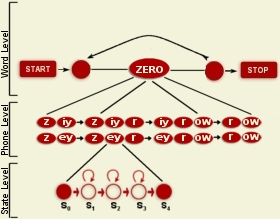|
4.2.4 Network Decoding:
Recognition Using Word-Internal Context-Dependent Phones The previous section introduced the concept of speech recognition using phones and discussed the concept of context-independent phones. This section will introduce context-dependent phones and discuss how they differ from context-independent phone models. The experiment below decodes a single utterance using context-dependent phones. Go to the directory $ISIP_TUTORIAL/sections/s04/s04_02_p04/.
Command: isip_recognize -parameter_file params_decode.sof -list /ftp/pu./projects/speech/software/tutorials/production/Notice that the context_mode parameter of the parameter file has been set to SYMBOL_INTERNAL in order to indicate to the recognizer that the models being used are word internal models. The rest of the parameters are the same as for the previous recognition experiments.
|
